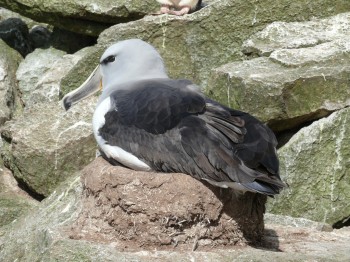Barry Baker (Latitude 42 Environmental Consultants) and colleagues have produced a report for the Conservation Services Programme of New Zealand's Department of Conservation on the results of an aerial survey of Salvin’s Albatross Thalassarche salvini on the Western Chain, Snares Islands (click here).
The report’s Executive Summary follows:
“Salvin’s albatrosses Thalassarche salvini is an abundant albatross species in New Zealand, breeding mainly on the Bounty Islands and the Western Chain of The Snares. The species roams widely in winter, moving eastwards across the South Pacific to the waters off the west coast of South America. In September 2014 we completed an aerial survey of the Western Chain, The Snares, and photographed all albatross colonies we observed. Salvin’s albatross was breeding on two (Rima and Toru) of the five islets in the Western Chain archipelago. The photographs were used to compile photo-montages of each colony, and these images were used to count birds on each islet. Ground counts of nesting Salvin’s albatrosses were also undertaken on Toru Islet on the day that aerial photography was undertaken. We estimated the total number of Salvin’s albatrosses ashore in the Western Chain in 17 September 2014 to be 2,307 (95% CI 2,211 — 2,403. Of these, 675 (CI 623 — 727) were on Rima Islet, and 1,632 (CI 1,551 — 1,713) were on Toru Islet. Ground counts at Toru Islet showed that of 171 birds ashore, 100 (58.5%) were incubating, 14 (8.2 %) were on empty nests, and 57 (33.3 %) were loafing. ‘Close up’ photographs taken using a large telephoto lens to assess the proportion of breeding and loafing birds were not useful for this purpose because we were unable to determine if most of the birds visible were clearly associated with a nest. Raw counts of birds ashore were adjusted to account for the presence of loafers. This provided an estimate of 1,486 (95% CI 1,409 — 1,563) annual breeding pairs in 2014/15, which was 32% higher than the ground counts undertaken on the same day of the aerial survey. Aerial survey proved to be an effective method of rapidly assessing the population size of Salvin’s albatross in the Western Chain, The Snares. Despite the difference between the aerial and ground counts, it should not be assumed at this stage that one survey methodology is more accurate than the other, as there is potential for error using both methods. The use of close up aerial photographs has proven useful in correcting raw counts to estimate the number of annual nesting pairs at other albatross colonies, but their utility for this purpose at the Western Chain, would appear to be limited. Ground counts indicated the proportion of loafing birds in colonies (33.3%) was high, but consistent with that observed at the Bounty Islands (25.8%) in 2013. These values exceed those previously recorded for other Thalassarche albatrosses during the early to mid-incubation period, but may be normal for Salvin’s albatross because of the nature of their nesting sites where egg loss appears to be very high. The cause of many nest failures appeared to be a combination of the lack of substrate with which to construct a nest, and interference from birds attending the colony. If population size (annual breeding pairs) is to be regularly estimated using aerial photography, it would appear more appropriate to use the correction factor derived by the 2014 ground count to adjust raw counts each year, noting that this correction factor will likely be dependent on the time of the breeding season that the count is undertaken. Further ground-truthing undertaken concurrently with aerial photography would be of use to refine the correction factor. Alternatively, aerial photography could be used to simply assess the number of birds ashore and use this as an index of abundance to assess population trend over time.”

Salvin's Albatross on the Snares, photograph by Paul Sagar
With thanks to Barry Baker.
Reference:
Baker, B.G., Jensz, K., Sagar, P. 2015. 2014 Aerial survey of Salvin's albatross at The Snares, Western Chain. Final Report prepared for Department of Conservation Project POP2014-02 Objective 2A. [Kettering]: Latitude 42 Environmental Consultants Pty Ltd. 9 pp.
John Cooper, ACAP Information Officer, 26 May 2015

 English
English  Français
Français  Español
Español